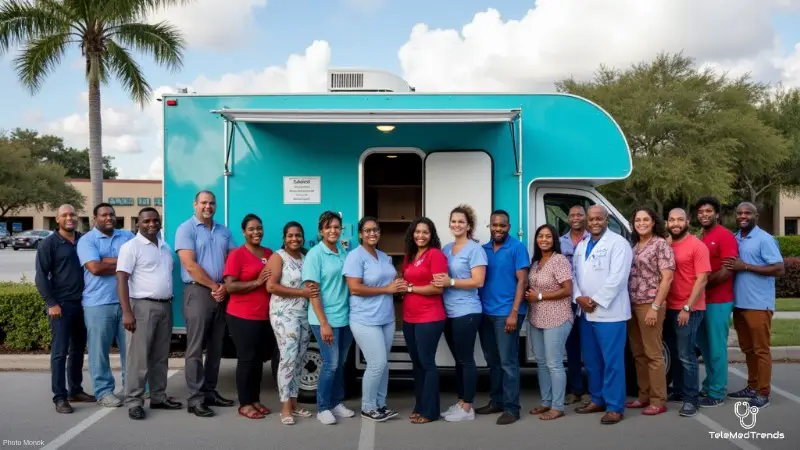Homeless individuals often struggle with limited healthcare access, leading to untreated conditions and frequent emergency visits. To address this issue, the OnMed CareStation at Tampa Hope provides on-site telehealth services, ensuring timely and affordable care. This advanced ‘clinic in a box’ has been installed at the shelter to offer immediate and accessible medical support for unhoused individuals.
This enclosed 8-by-11-foot medical pod functions as a fully equipped exam room featuring thermal imaging, vital sign monitoring, and a high-definition camera for real-time telehealth consultations. The initiative, a collaborative effort between Tampa General Hospital, Catholic Charities, and the city of Tampa, aims to remove common barriers to healthcare, such as transportation and cost.
Residents like Sam Harris, a stroke survivor, have found relief in the ability to check their vitals anytime and access emergency services if needed. The CareStation also allows for early diagnosis and treatment of medical conditions, preventing complications that may otherwise lead to emergency room visits.
A certified nursing assistant assists patients through the intake process before connecting them with an OnMed clinician, ensuring a seamless and supportive healthcare experience. Tampa Mayor Jane Castor has lauded the initiative as a game-changer in providing proactive medical care to vulnerable populations.
Key Takeaways
OnMed CareStation at Tampa Hope provides on-site telehealth services, ensuring timely and affordable care for homeless individuals.
- The OnMed CareStation has reduced emergency calls from Tampa Hope residents by 50% in the last three months of 2024.
- The initiative aims to remove common barriers to healthcare, such as transportation and cost, through its on-site medical pod.
- The program not only improves individual health outcomes but also contributes to more efficient use of city resources.
Cutting ER visits and healthcare costs
The introduction of the OnMed CareStation has already demonstrated significant benefits. According to Catholic Charities’ Executive Director, Maggie Rogers, emergency calls from Tampa Hope residents have dropped by 50% in the last three months of 2024.
And so really, the benefit … is they see doctors without taking time from ER doctors needed for other patients.
Maggie Rogers
This reduction highlights the station’s effectiveness in addressing non-emergency health concerns before they escalate, ultimately alleviating strain on hospital emergency departments. By diverting minor medical cases away from hospitals, the initiative ensures emergency medical staff can focus on critical cases.
Mayor Castor also emphasized the economic advantages of the CareStation, pointing out the substantial cost savings resulting from reduced emergency room visits and ambulance transports. By making healthcare more accessible at the shelter, the program not only improves individual health outcomes but also contributes to more efficient use of city resources.
Funding and future expansion
The Tampa Hope CareStation is the first of its kind to be placed in a homeless shelter, marking a significant milestone for OnMed. The project was made possible through a $1 million allocation from the city, with additional first-year funding from Tampa General Hospital and the McNamara Family Foundation.
OnMed has already deployed CareStations in universities, community centers, and prisons across six states, but the success of the Tampa Hope installation has drawn interest as a model for other cities facing similar healthcare challenges. OnMed CEO Karthik Ganesh believes this project sets a precedent for future collaborations between healthcare providers and municipalities seeking to address homelessness and medical accessibility.
Through this innovative program, we can provide accessible world-class health and wellness care to Tampa Hope residents when and where they need it.
John Couris
John Couris, CEO of Tampa General Hospital, reinforced the hospital’s commitment to community healthcare, stating that the CareStation provides world-class medical support where it is needed most. The system’s ability to issue e-prescriptions and maintain electronic medical records ensures continuity of care for patients beyond their visit. With automated sanitization cycles after each use, the CareStation also maintains a safe and hygienic healthcare environment.
As city leaders and healthcare providers plan for the future, Mayor Castor is optimistic about securing funding to expand this program. The OnMed CareStation has already improved healthcare access for Tampa’s homeless, reducing emergency visits and providing consistent care.
With continued support, similar models could be introduced in other shelters and underserved areas. This initiative positions Tampa as a leader in using technology-driven healthcare to address homelessness and could serve as a model for other cities.






